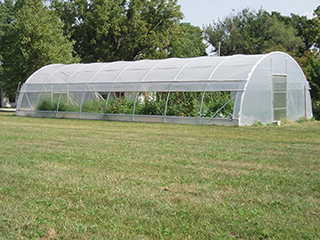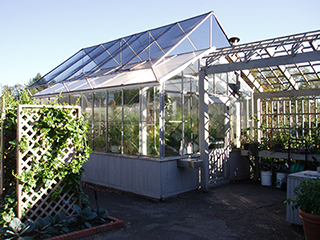G2246
Cold Frames, High Tunnels, and Greenhouses:
Choose a Growing Structure Best for You
Cold frames, high tunnels, and greenhouses are growing structures that can be used to extend the growing season for high value horticulture crops.
Stacy A. Adams, Associate Professor of Practice
Kim Todd, Extension Landscape Horticulture Specialist
|
Several different types of growing structures are used in the production of high value horticulture crops. These structures extend the growing season by modifying the growing environment, and are used by gardeners, hobby farmers, and market growers.
Growing structures create a protected environment for producing vegetables, high value food crops, and flowering plants. The most commonly used structures are cold frames, high tunnels, and greenhouses. These structures provide optimum environmental conditions for early season production of plants or to allow crops to be harvested after fall frosts. Structures with more elaborate and extensive integrated heating and cooling equipment can be used throughout the year. Structure differences include size and shape, construction materials used, and installation method, and the way the interior temperature is managed such as by opening vents or windows by hand or using automated heating and cooling systems. Before buying a growing structure, it is important to understand which type is most appropriate for your location and needs.
Cold Frames
Cold frames are the smallest, simplest, and least expensive structures for protecting plants. Cold frames capture daytime solar energy to heat the air space and soil floor or containers instead of using electrical energy to heat the growing area. The low structural design provides warmer nighttime air temperatures around the plants by slowly releasing heat that has collected in the soil on the floor or in growing containers, thus preventing cold injury to the plants in the cold frame (Figure 1).
|
By using a cold frame, spring planting can occur as much as three to five weeks earlier, and the fall season can extend that far beyond frost date. During the winter, cold frames are used to protect tender perennials by controlling excessively cold exposure, abrupt temperature changes, and by reducing soil moisture loss through evaporation.
Cold frames let home gardeners take advantage of spring temperatures for growing crops such as lettuce, spinach, and broccoli that thrive in cool weather. For earlier fruiting of tomatoes and peppers, gardeners can germinate seeds indoors, then transfer the young seedlings to cold frames. This provides early season protection and allows them to “harden off.” Hardening off is the process of gradually exposing plants grown in greenhouses to outdoor conditions, including cool air temperatures, and increased light intensity and air movement. Plants respond to this process by slowing stem elongation and strengthening soft growth. Home gardeners can successfully produce plants in cold frames that are constructed of a perimeter wood frame box set directly on the ground with a glass, acrylic, or a polyethylene plastic cover (Figure 2). Manufacturers of cold frames offer options such as automatic vents and heating cables that can be added.
Commercial Use of Cold Frames
Commercial growers and retailers use cold frames for winter protection of container trees, shrubs, and perennials, and for forcing early spring flowering shrubs and perennials. Commercial growers typically use unheated, low profile, walk-in half-hoop structures varying in width from 14 feet to 24 feet and of unlimited length. They are covered with a single layer of white or clear polyethylene film for overwintering plant material. Temperatures in cold frames are controlled by opening and closing the outer roof covering or the end doors. The low structural profile keeps the warmer air closer to the floor where the plants are being held, increasing the winter survival of container plants.
After danger of frost, the polyethylene covering on cold frames is generally removed. Shade cloth can be applied for growing or holding plants that thrive in shade or for protection from high winds and hail. Black cloth may be used to initiate blooming of short day plants (Figure 3). Nursery growers may modify cold frames for propagating new plants by inserting heating cables into raised beds filled with sand or fine gravel. These “hotbeds” create optimum conditions for starting woody plant cuttings by slowing plant top growth while the base of the cutting forms callous and new roots.
High Tunnels
High tunnels are traditionally inexpensive, simply constructed structures that are similar to cold frames in the way they capture solar heat energy and protect plants from the environment. However, high tunnels are much taller and often wider than cold frames (Figure 4). They can be used by home gardeners but are more often are used by commercial growers or farmers for the production of specialty crops, such as cut flowers or fruit and vegetable crops grown out of season. High tunnels can be stand-alone structures or grouped and connected at the eave or gutter sides to create larger contiguous growing areas. These structures are covered with a single layer of greenhouse grade polyethylene plastic and typically use only solar heating and natural cooling methods.
High tunnels are larger than cold frames, allowing for more efficient use of floor space to grow taller plants to full maturity. These structures lack foundations and durable sidewalls. They are constructed of supporting hoops or bows that are anchored by sinking stakes directly into the ground or into concrete piers. To increase structural strength, hoop spacing can be narrowed and additional internal supports, including roof purlins and wind braces, can be added. End walls typically have sliding or swinging doors that also can be used for general access and for increasing air movement within the structure. Larger doors or openings can be designed to allow for use of larger equipment in the high tunnel.
Wider high tunnels provide more usable growing space for the earliest in-ground crop production. This is because soil temperatures around the perimeter of the side walls and end walls will be too cool for most crops, since cold air leaks along the sidewalls and cool temperatures move through the soil from outside the structure. The cold temperature effect along the wall may be reduced by using perimeter baseboards attached to the bows (Figure 5), installing insulation foam board along the baseboard, or by sealing roll-up walls in the winter.
 |
 |
|
Figure 4. A high tunnel with roll-up sidewalls used for production of vegetable crops. |
Figure 5. Baseboard installed at the base of a high tunnel to reduce cold air movement into the protected growing area. Note the polyethylene covering has been sealed tightly for winter, and the grower is using a fabric covering to keep lettuce warmer on the ground bed. |
Controlling interior temperature is done manually by opening doors and rolling up the sidewalls. Electrical power is not generally used but recent advancements in solar collectors, batteries, and 12-volt motorized greenhouse equipment have made automation of roll-up walls feasible. This allows for improved temperature regulation with a reduction in operational labor. High tunnels and cold frames are both structures that also can be used to support permaculture production practices.
Greenhouses
A growing structure that integrates supplemental heating and cooling systems can be used throughout the year and is known as a greenhouse or hothouse. The design and construction of these structures is more substantial, given the permanency of the heating, electrical, plumbing and cooling equipment that is required for their use. Greenhouses can be customized to provide the perfect environment for growing anything from tropical flowers to cacti and seedlings to completely mature fruiting plants.
Selecting the size, shape, and construction materials for a greenhouse should be based on the desired crops. A perimeter or pier foundation is necessary for most greenhouses to support the structural framing, especially if a rigid type of outer covering will be used. Greenhouse coverings may be similar to those used on high tunnels, including greenhouse grade polyethylene film and polycarbonate panels. More durable and longer lasting coverings include twin wall polycarbonate and single or twin wall acrylic panels. Glass is less often used because of its energy inefficiency, risk of breakage, and significant weight that requires greater greenhouse structural strength. The greenhouse structure must not only be strong enough to support the outer covering, but also the heating and cooling equipment, the effects of high winds or snow loads, and the weight of hanging plants or trellises (Figures 6, 7).
 |
 |
|
Figure 6. A hobby greenhouse with glass sidewalls and polycarbonate roof covering. |
Figure 7. A large production greenhouse with corrugated polycarbonate covering and insulated curtain wall. |
Greenhouse temperatures must be efficiently controlled to maintain an optimal growing environment. This requires an outer covering capable of providing high light transparency, while minimizing heat loss and air leakage. The heating system must be properly sized for the exterior covering and meet the square footage requirement with adjustments made for environmental exposure at the specific site location. Operational costs are highly dependent on the type of exterior covering; air leakage; and the quantity of heating, ventilation, and controls being used.
Hobbyists can find greenhouse kit suppliers easily on the Web; however, carefully assess the design and quality of the components before making an online purchase. In addition, contact the local building permits office during the planning stage to verify that the structural design and siting of the planned growing structure is in compliance with applicable codes. High tunnels may be considered temporary structures unless they are heated or have been permanently anchored into concrete, in which case they may be categorized as greenhouses by building code. Even if no local building codes govern construction in the community, purchase materials or structures that meet the Uniform Building Code for greenhouses.
Summary
Cold frames, high tunnels, and greenhouses are structures that provide hobbyists and growers with options for plant protection and season extension. They vary in cost, size, structural complexity, and ability for year-round usage. The small cold frame is the most affordable option for beginning growers. With experience, growers may choose a high tunnel or greenhouse for optimal production and economic gain.
This publication has been peer reviewed.
Visit the University of Nebraska–Lincoln Extension Publications website for more publications.
Index: Lawn & Garden
Miscellaneous
Issued September 2014


